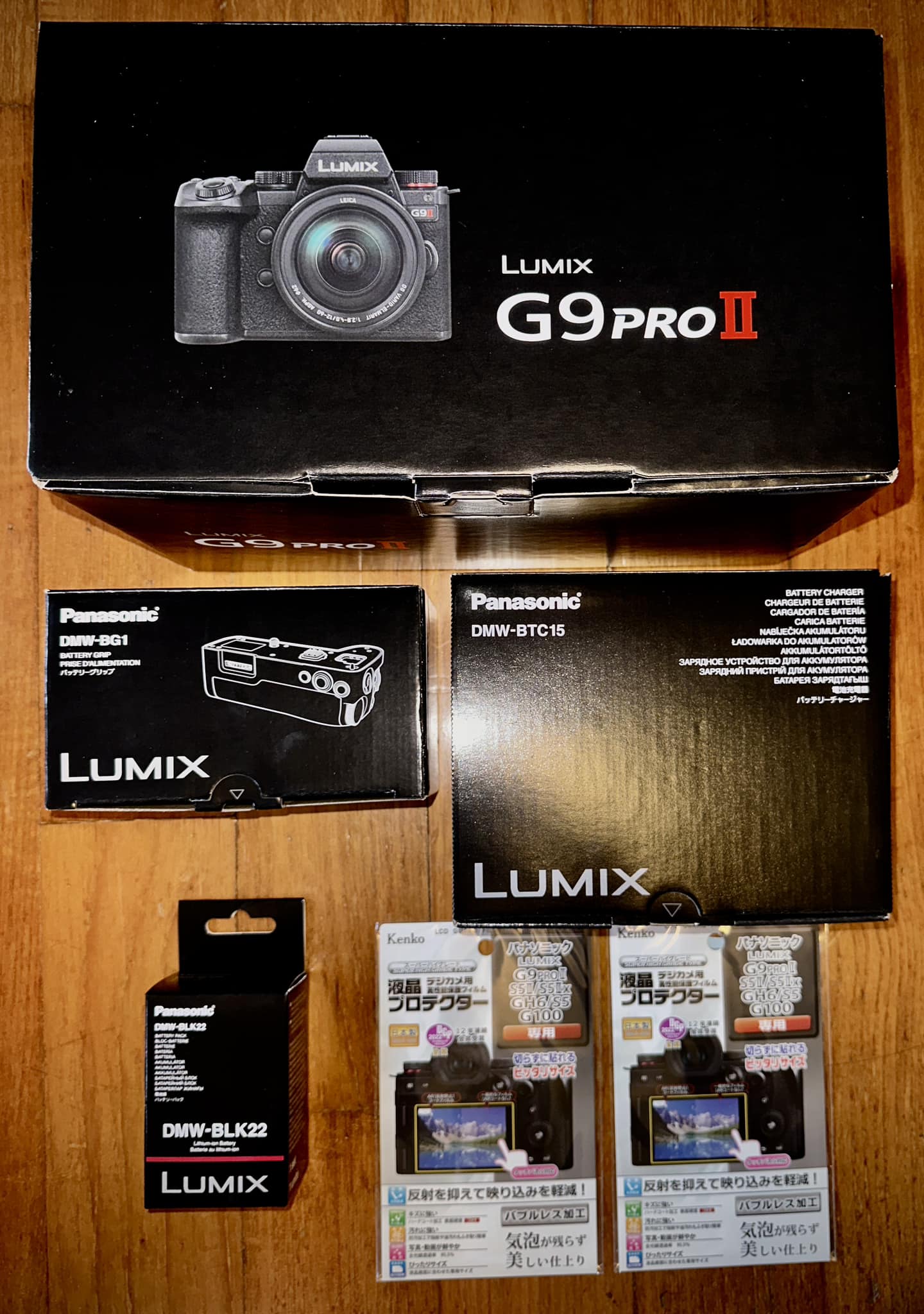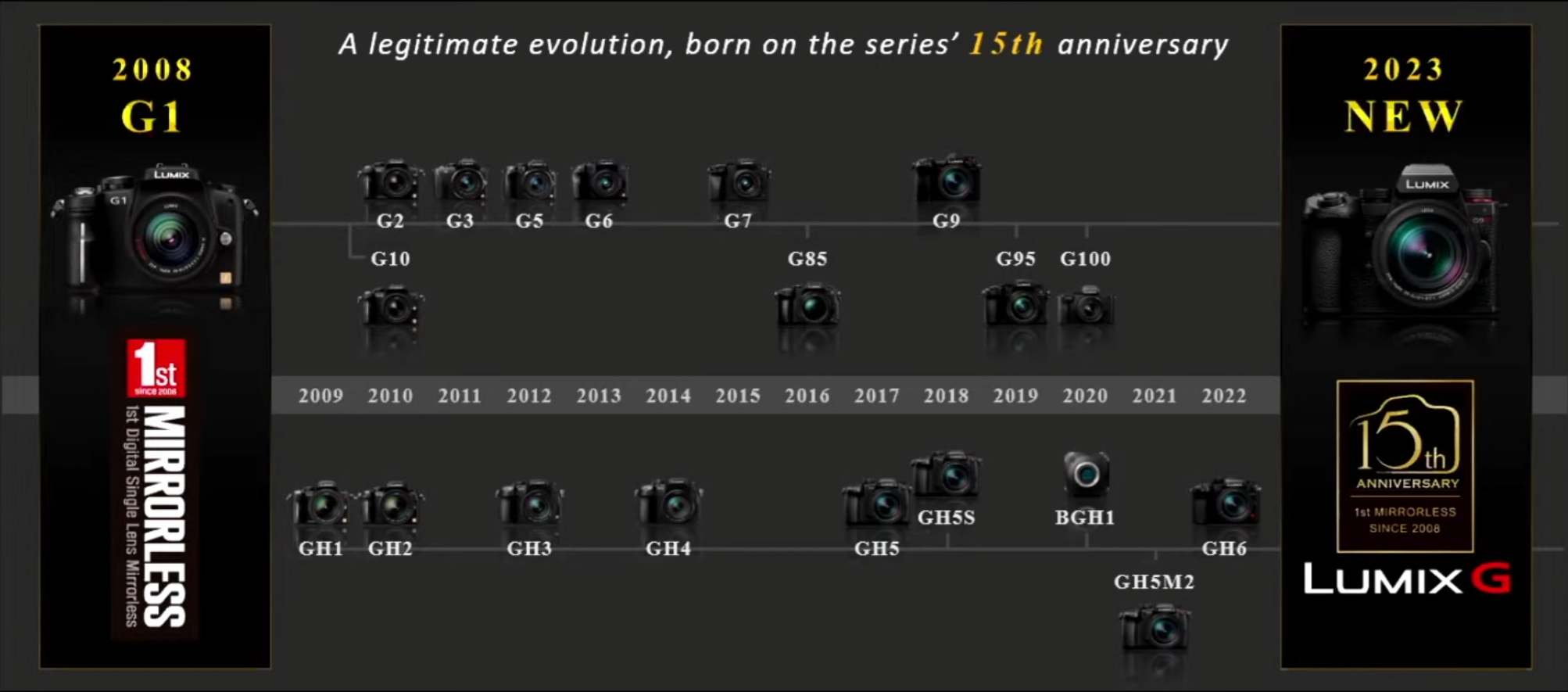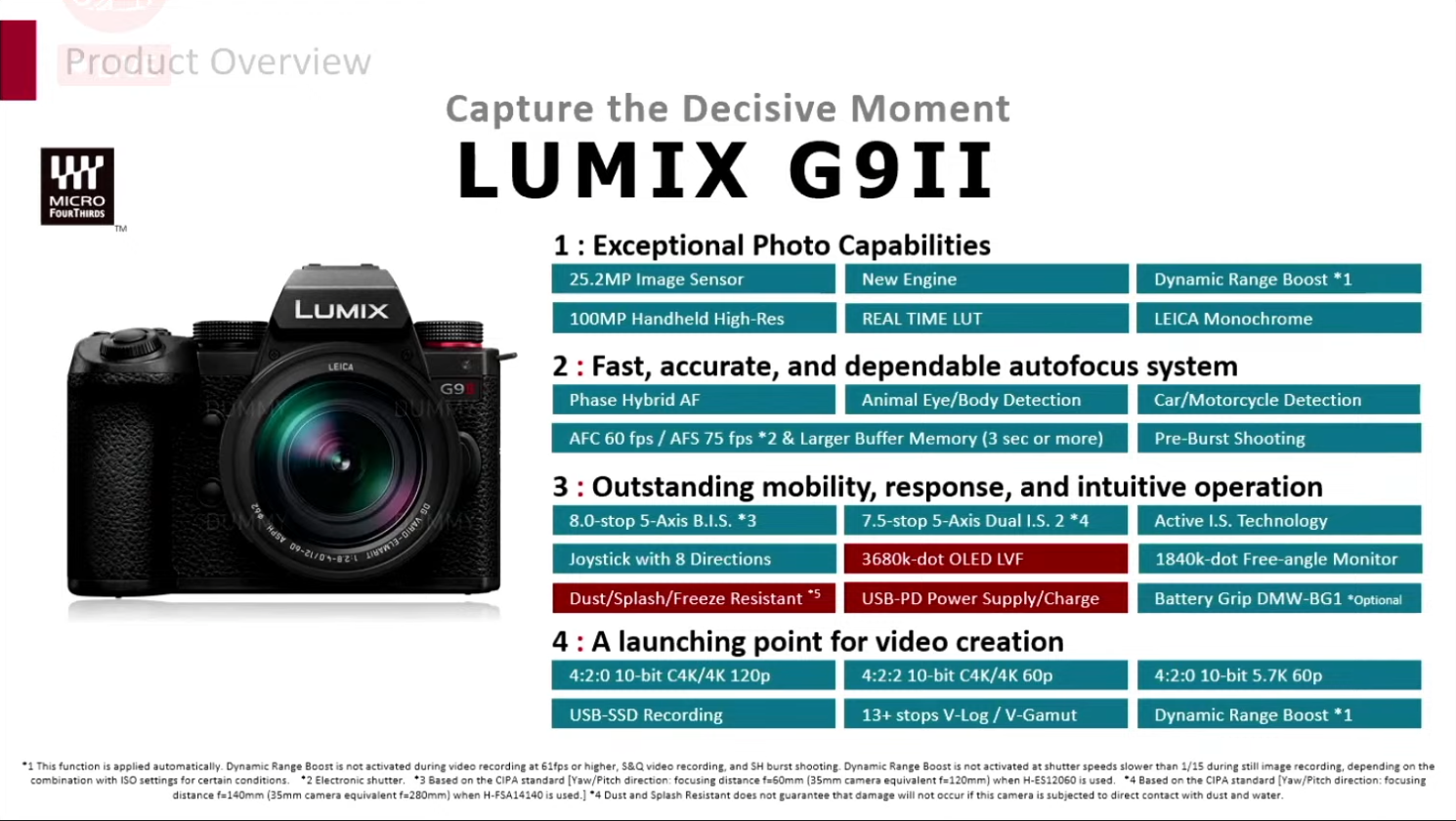
It allows to keep PV going, with more focus towards AI, but keeping be one of the few truly independent places.
-
Panasonic is proud to announce the launch of the LUMIX G9II digital mirrorless camera, equipped with a new sensor and Phase Detection Auto-Focus (PDAF) technology. The LUMIX G9II is the first camera in the Micro Four Thirds LUMIX G Series to feature PDAF technology.
In line with the growing need to produce highly creative artwork and photography using diverse methods, this new model creates high-resolution, high-quality images and rich colors straight out of camera. Furthermore, with a new auto-focus technology that combines Panasonic's accumulated expertise in recognition technology with PDAF, and a high-speed burst shooting mode that ensures decisive moments are always captured, this new model boasts significantly improved power and high-speed performance. The camera supports photographers from various fields using a system that can be combined with the compact and lightweight LUMIX G Micro Four Thirds lenses for ultimate flexibility.
- New Sensor and New Engine Boasting Outstanding Photographic Performance
- PDAF technology implemented in LUMIX G Series for the First Time
- Flagship Micro Four Thirds Model for Still Images with Improved High-Speed Performance and Ergonomics
The new 25.2-megapixel Live MOS Sensor and new engine produce high-resolution images in outstanding quality with rich color tones, while the hybrid PDAF technology enables accurate auto-focus and high-speed tracking of fast-moving subjects. Moreover, burst shooting at 60 fps in AFC mode and SH pre-burst recording*1 that begins before the shutter is released ensures that the decisive moment is always captured, even with dynamically moving subjects.
LUMIX's popular image stabilization system is further improved, combining 8-stop2 B.I.S. (Body Image Stabilizer), 7.5-stop3 5-axis Dual I.S. 2, and advanced Active I.S. for incredible video image stabilization. Together, these functions provide even greater support for handheld shooting of dynamic scenes that would previously have been difficult to capture. In addition, creators can enjoy enhanced monochrome photo styles with new LEICA Monochrome and REAL TIME LUT for preferred color settings. Through this next-generation digital mirrorless camera, Panasonic intends to respond to the needs of creators who are pursuing methods of creative expression that go beyond the boundaries of photography and videography.
Main features
- Equipped with a new sensor, new engine, and the first PDAF implementation in LUMIX G Series for outstanding photographic performance and high-speed response
- New 25.2-megapixel Live MOS Sensor for high resolution and high-speed response (13+ stop4 V-Log/V-Gamut, Dynamic Range Boost5)
- New engine that achieves natural, three-dimensional textured images and ensures high-speed processing of high bitrate video
- Use of new AI-powered recognition technology (developed using deep learning technology) for real-time auto-focus recognition that now recognizes cars, motorcycles, and animal eyes for improved precision in subject recognition
Advanced high-speed performance to ensure decisive moments is always captured
- Burst shooting at 60 fps in AFC mode and reinforced buffer memory for continuous burst shooting over three seconds for ensuring the capture of targeted moments
- SH pre-burst recording*1 that can begin shooting up to 1.5 seconds before the shutter is released and take approximately 113 consecutive shots
- Robust image stabilization system with 8-stop2 B.I.S. (Body Image Stabilizer), 7.5-stop3 5-axis Dual I.S. 2, with perspective distortion correction for video, and high mode for advanced Active I.S.
- Highly-mobile camera system combined with the compact, lightweight, and diverse range of LUMIX G Series lenses
New modes expand the possibilities of creative photography
- REAL TIME LUT function enabling personalized color expression through use of LUT files
- Enhanced monochrome mode with newly added LEICA Monochrome for deep black-white contrasts
- Hand-held 100-megapixel High Resolution mode and Live View Composite mode to expand the range of photographic options
A launching point for video creation
- 4:2:0 10-bit 5.8K (4:3) full sensor recording/ 5.7K (17:9) enables flexible framing options for various social media formats
- 4:2:0 10 bit C4K/4K 120p/100p enables slow motion videos
- Apple ProRes*6 video, which delivers high image quality at low compression, reducing the load on the computer during post-production and allows non-linear editing without transcoding, streamlining your workflow from start to finish.
- Recording and playback are supported using an external SSD via USB
- Active I.S. Technology corrects shake when shooting on the move
Pricing and Availability:
-
One week after the G9M2 launch and there is reports on extremely slow pre-order sales.
BTW: The G9M2 MSRP of $1900 is basically to high. This is a $1300 max camera. Maybe even less.
And;
OM killed the m43 system selling it out to JIP, despite numerous claims on how the camera business was an essential part of the medical imaging business.
Panasonic killed m43 going all in on Lumix S.
-
Sadly the Panasonic "mysterium" sensor can not compete with the stacked BSI sensor from Sony (aka OM-1 sensor). The price for Panasonic going PDAF it seems.
-
Problem is that size if near FF and you can get FF bodies for similar prices.
-
Sean @ Lumix Live had some ramblings about the G9M2 sensor in todays live broadcast - which is claimed to be totally reworked design from the GH6 sensor. Alas, the claim is that the G9M2 sensor is a BSI type sensor (but not stacked - which destroys dynamic range he has previously stated).
-
I wonder how many camera models it will take for Panasonic to stop producing 2nd rate m4/3 cameras. I mean, are we looking at 2025? 2030?
-
Quite long ago I told that they must make universal bodies. QR mounted EVFs, QR mounted screens.
And just 4 big screws to replace main board (it must be covered in special box with fan and not exposed) and sensor assembly.
And this is it.
Such way people can upgrade 10 year old camera to latest AI one that can just ask you question and redo all photo adding naked wife of Panasonic manager to the shot :-)
-
For some reason the Japan domestic model is called the G9 PRO II.
And if you want the battery charger it's extra.


 396536032_333094232756568_1715728556585092957_n.jpg1440 x 2048 - 276K
396536032_333094232756568_1715728556585092957_n.jpg1440 x 2048 - 276K -
Also the original G9 was called G9 Pro in Japan.
-
WOW!
"It has a good dynamic range for a Micro Four Thirds system that uses 4/3 type LiveMOS. Although the performance is not comparable to that of the high-performance APS-C, I don't think there are any cameras that have better MFT performance.
At least the dynamic range is better than the rival OM SYSTEM OM-1. In particular, you can expect much better results when developing RAW with dark areas lifted."
-
The funny part is that this camera may have somewhat similar DOF in daily, an equal amount of noise but better DR compared to the Sony A9III (which costs 7 times more).
In my humble opinion, I see no benefit for a global shutter camera this expensive and with so many limitations!
-
Pro sounds nice, Pro sounds important :-)
-
You know when they call it "PRO" it's never professional. GoPro. Røde Wireless Pro. Etc. ;-)
-
Firmware Version 2.0 for LUMIX G9II To Support HDMI RAW Data output for BRAW and Pro Res RAW recording.
Newark, NJ (December 4th, 2023)
Panasonic announced the upcoming release of the Ver.2.0 firmware update program for the LUMIX G9II to offer more flexible workflow. The firmware program will be available on the LUMIX Global Customer Support website.
LUMIX G9II Firmware Version 2.0
Details are still under development and subject to change.
RAW video output over HDMI to Blackmagic Design external recorder
[5.7K] / [C4K] / [5.8K(4:3)] / [4.4K(4:3)] 12-bit RAW video data can be output over HDMI to Blackmagic Video Assist 5" 12G HDR and Blackmagic Video Assist 7" 12G HDR, to be recorded as Blackmagic RAW.
DaVinci Resolve or DaVinci Resolve Studio is required to play back and DaVinci Resolve Studio to edit Blackmagic RAW data.
RAW video output over HDMI to ATOMOS external recorder
[5.7K] / [C4K] / [5.8K(4:3)] / [4.4K(4:3)] 12-bit RAW video data can be output over HDMI to ATOMOS "Ninja V" "Ninja V+" "Ninja" "Ninja Ultra" "Shogun" "Shogun Ultra" "Shogun Connect" devices, to be recorded as Apple Pro Res RAW.
-
Trivia: If you listen to the m43 rumours christmas live stream on december 22, he again repeated the claim that the G9 is selling below expectations. Look out for better deals on this camera next year I presume.
-
:))) such a device should cost no more than 1200-1300 dollars
Howdy, Stranger!
It looks like you're new here. If you want to get involved, click one of these buttons!
Categories
- Topics List23,993
- Blog5,725
- General and News1,354
- Hacks and Patches1,153
- ↳ Top Settings33
- ↳ Beginners256
- ↳ Archives402
- ↳ Hacks News and Development56
- Cameras2,368
- ↳ Panasonic995
- ↳ Canon118
- ↳ Sony156
- ↳ Nikon96
- ↳ Pentax and Samsung70
- ↳ Olympus and Fujifilm102
- ↳ Compacts and Camcorders300
- ↳ Smartphones for video97
- ↳ Pro Video Cameras191
- ↳ BlackMagic and other raw cameras116
- Skill1,960
- ↳ Business and distribution66
- ↳ Preparation, scripts and legal38
- ↳ Art149
- ↳ Import, Convert, Exporting291
- ↳ Editors191
- ↳ Effects and stunts115
- ↳ Color grading197
- ↳ Sound and Music280
- ↳ Lighting96
- ↳ Software and storage tips266
- Gear5,420
- ↳ Filters, Adapters, Matte boxes344
- ↳ Lenses1,582
- ↳ Follow focus and gears93
- ↳ Sound499
- ↳ Lighting gear314
- ↳ Camera movement230
- ↳ Gimbals and copters302
- ↳ Rigs and related stuff273
- ↳ Power solutions83
- ↳ Monitors and viewfinders340
- ↳ Tripods and fluid heads139
- ↳ Storage286
- ↳ Computers and studio gear560
- ↳ VR and 3D248
- Showcase1,859
- Marketplace2,834
- Offtopic1,320











